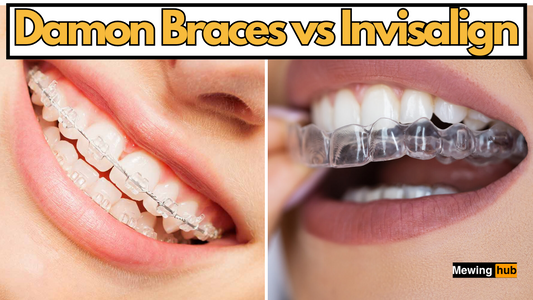Collagen Maxxing: The Science-Backed Approach to Looksmaxxing

Share
In the world of looksmaxxing, collagen maxxing has emerged as a powerful strategy for enhancing skin appearance and maintaining a youthful look.
This comprehensive guide will delve into the science behind collagen production, the most effective supplements, and topical treatments for maximizing your collagen levels.
Understanding Collagen Synthesis
To truly optimize collagen production, it's crucial to understand the process at a cellular level. Collagen synthesis involves several key steps and requires specific nutrients as cofactors:
- mRNA translation in the cytoplasm (requires magnesium and zinc)
- Polypeptide chain modification in the endoplasmic reticulum (requires iron and vitamin C)
- Procollagen formation and release from fibroblasts
- Conversion of procollagen to tropocollagen
- Formation of collagen fibrils through covalent bonding
The Role of Fibroblasts
Fibroblasts are the primary cells responsible for collagen production in the skin. These cells are located in the dermis and play a crucial role in maintaining skin structure and elasticity. Stimulating fibroblast activity is key to enhancing collagen production.
Types of Collagen
There are at least 16 types of collagen in the human body, but types I, II, and III are the most abundant:
- Type I: Found in skin, tendons, and bones
- Type II: Primarily in cartilage
- Type III: Present in skin, muscles, and blood vessels
For skin health and appearance, focusing on types I and III is most beneficial.
Essential Nutrients for Collagen Production

Based on the synthesis process, the following nutrients are crucial for optimal collagen production:
- Magnesium: Supports enzyme function in collagen synthesis
- Zinc: Essential for collagen formation and repair
- Iron: Required for hydroxylation of proline and lysine in collagen
- Vitamin C: Crucial for collagen synthesis and acts as an antioxidant
Ensuring adequate intake of these nutrients through diet or supplementation is fundamental to any collagen maxxing routine.
Dietary Sources of Collagen-Boosting Nutrients
- Magnesium: Leafy greens, nuts, seeds, whole grains
- Zinc: Oysters, beef, pumpkin seeds, lentils
- Iron: Red meat, spinach, lentils, fortified cereals
- Vitamin C: Citrus fruits, bell peppers, broccoli, strawberries
Oral Supplements for Collagen Maxxing
While many supplements claim to boost collagen, scientific evidence supports the efficacy of the following:
1. Astaxanthin with Hydrolyzed Collagen
This powerful combination upregulates type I procollagen gene expression and decreases MMP-1 and MMP-12, enzymes responsible for collagen degradation.Dosage: 4-12mg of astaxanthin daily, combined with 10-20g of hydrolyzed collagen
2. Pycnogenol (OPCs)
A potent polyphenol that stimulates type I collagen synthesis, increasing gene expression by an impressive 41%.Dosage: 50-100mg daily
3. Orthosilicic Acid (BioSil)
Stimulates collagen type 1 synthesis and promotes osteoblastic differentiation in human cells.Dosage: 10-20mg of silicon daily
4. Red Panax Ginseng
Processed panax ginseng stimulates type I collagen by regulating MMP-1 and TIMP-1 expression in human dermal fibroblasts.
Dosage: 200-400mg daily of standardized extract
5. Honeybee Royal Jelly Extract
Contains 10-hydroxy-2-decenoic acid, which stimulates collagen synthesis by producing transforming growth factor (TGF) β1.
Dosage: 1000-2000mg daily
6. Aloe Vera
The polysaccharide acemannan in aloe vera promotes collagen biosynthesis.
Dosage: 10-30ml of aloe vera juice daily
Topical Treatments for Collagen Looksmaxxing
Incorporating these scientifically-proven topical treatments can significantly enhance your collagen maxxing efforts:

1. Tretinoin (0.025%+)
Increases type I and type III collagen while inhibiting MMP-1 expression.
Application: Start with 0.025% and gradually increase to 0.05% or 0.1% as tolerated
2. Vitamin C Serum (20% with Vitamin E and Ferulic Acid)
Stimulates type I and type III collagen synthesis, suppresses collagen-degrading MMPs, and increases tissue inhibitors of MMPs. For optimal results, use a serum with 20% concentration and a pH of 3.2.
Application: Apply once daily, preferably in the morning under sunscreen
3. Niacinamide (5%)
May stimulate collagen synthesis and increase dermal matrix collagen production.
Application: Use twice daily, morning and night
4. Glycolic Acid Peels (20%)
Increases type I collagen mRNA and hyaluronic acid content in human skin.
Application: Start with monthly treatments, gradually increasing frequency as tolerated
Peptides for Advanced Collagen Maxxing

Incorporating specific peptides can take your collagen maxxing routine to the next level:
1. Matrixyl 3000 (8%)
Stimulates type I collagen, fibronectin, and hyaluronic acid production.
2. Matrixyl Synthe'6 (2%)
Promotes synthesis of type I, III, and IV collagen, as well as fibronectin and hyaluronic acid.
3. Original Matrixyl
Stimulates collagen types I, III, and IV, along with elastin and fibronectin.
4. Tetrapeptide-21 and EGF (Human Oligopeptide-1)
Popular in advanced skincare routines for their collagen-boosting properties.
Application: Look for serums or creams containing these peptides and apply twice daily
Innovative Ingredients for Collagen Synthesis
Centella Asiatica Extract (Madecassosides)
This lesser-known ingredient stimulates type I collagen synthesis in human dermal fibroblast cells. Look for creams containing at least 0.1% madecassosides for optimal results.Application: Use twice daily as part of your skincare routine
Sun Protection: A Crucial Aspect of Collagen Maxxing
Protecting your skin from UV damage is essential for maintaining collagen levels.

Use a broad-spectrum sunscreen with the following characteristics:
- SPF 50+ PA++++
- Photostable UV filters (e.g., zinc oxide and titanium dioxide)
- Protects against both UVA (responsible for premature aging) and UVB (causes sunburn) rays
Application: Apply generously 15-30 minutes before sun exposure, reapply every 2 hours or after swimming/sweating
Lifestyle Factors for Collagen Maxxing
In addition to supplements and topical treatments, certain lifestyle factors can significantly impact collagen production:
- Sleep: Aim for 7-9 hours of quality sleep per night to support skin repair and regeneration
- Stress management: Chronic stress can accelerate collagen breakdown, so incorporate stress-reduction techniques like meditation or yoga
- Hydration: Adequate water intake supports overall skin health and collagen function
- Diet: Consume a balanced diet rich in antioxidants, lean proteins, and omega-3 fatty acids
- Exercise: Regular physical activity can boost collagen production and improve skin health
Advanced Collagen Maxxing Techniques
For those looking to take their collagen maxxing to the next level, consider these advanced techniques:
- Microneedling: Stimulates collagen production through controlled micro-injuries
- LED Light Therapy: Red and near-infrared light can boost collagen synthesis
- Radiofrequency Treatments: Non-invasive option for stimulating collagen production
- Platelet-Rich Plasma (PRP): Uses your own blood components to boost collagen
Creating Your Collagen Maxxing Routine
To maximize collagen production and achieve optimal results, consider incorporating the following steps into your daily routine:
-
Morning:
- Cleanse
- Apply vitamin C serum
- Use a moisturizer with peptides (e.g., Matrixyl 3000)
- Finish with broad-spectrum sunscreen
-
Evening:
- Double cleanse
- Apply tretinoin (alternate nights)
- Use a niacinamide serum
- Apply a moisturizer with centella asiatica extract
-
Weekly:
- Perform a 20% glycolic acid peel (follow instructions carefully)
-
Daily Supplements:
- Hydrolyzed collagen with astaxanthin
- Pycnogenol
- Orthosilicic acid
- Red panax ginseng
- Honeybee royal jelly extract
- Aloe vera supplement
Remember to introduce new products gradually and perform patch tests to avoid potential skin irritation.
Tracking Your Collagen Maxxing Progress
To ensure your collagen maxxing efforts are effective, consider these methods for tracking progress:
- Regular photos: Take consistent, well-lit photos to visually track changes
- Skin analysis tools: Use devices that measure skin elasticity and hydration
- Dermatologist visits: Regular check-ups can provide professional insight into your skin's health
- Skin biopsy: For the most accurate measurement of collagen levels (though invasive and not typically necessary)
Potential Side Effects and Precautions
While collagen maxxing is generally safe, be aware of potential side effects:
- Skin irritation from topical treatments
- Digestive issues from oral supplements
- Allergic reactions to certain ingredients
- Interactions with medications
Always consult with a healthcare professional before starting any new supplement regimen or intensive skincare routine.
Conclusion: Patience and Consistency in Collagen Maxxing
Collagen maxxing is a long-term commitment that requires patience and consistency. While some improvements may be noticeable within weeks, significant changes in skin texture, firmness, and overall appearance can take months to manifest.By combining evidence-based oral supplements, topical treatments, and proper sun protection, you can create a powerful collagen maxxing routine that supports your overall looksmaxxing goals.
Remember to approach your collagen maxxing journey with realistic expectations and a holistic view of skin health and beauty.Stay committed to your collagen maxxing routine, and you'll be on your way to achieving firmer, more youthful-looking skin that enhances your overall appearance and confidence.








